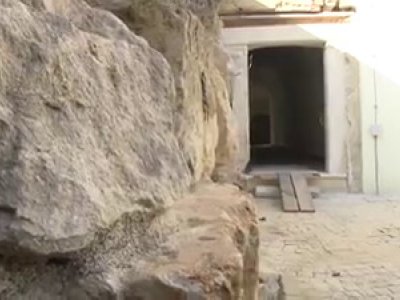Metropolitan Andrey Sheptytskyi Museum

Museum of Metropolitan Andrei Sheptytskyi is a place where, in addition to the story of the righteous Lord, you can get much more - sincerity, truth, and great energy.
On August 29, 2020, the Museum of Metropolitan Andrey Sheptytskyi opened its doors in Lviv. This landmark event was expected by many, given that 2020 marks the 155th anniversary of the Metropolitan's birth. Come to the museum and see that history comes alive and the walls speak. Hear that the work in which a person's soul has invested lives and ignites others. We are sure that you will be lucky and you will meet a unique and authentic pastor, hieromonk, father Dr. Sevastian (Stepan Dmytrokh), who is the abbot of the Church and the director of the museum (and will gladly give you an exciting tour). It was father Sevastiyan, 30 years old, who tirelessly worked on creating the Museum of Metropolitan Andrey Sheptytskyi. His dream finally came true, and the museum opened its doors to visitors. The museum's mission is to restore the memory of giants of Ukraine's spirit, thinkers, and builders and tell the whole world about the greatness of Metropolitan Andrey Sheptytskyi.
Exhibits
Stretcher (for transportation) of Metropolitan Andrey Sheptytskyi. Strong fabric. The end of the 1930s.
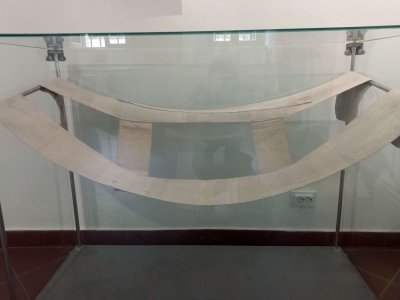
This is an unusual item of personal use, the so-called "metropolitan's stretchers". That's what the monks called among themselves, who took care of Metropolitan Andrei during his weak days on earth. They are two strong cloth panels of cream color, fastened together with transverse straps.
These stretchers are now on display in the metropolitan's storage room under a rectangular glass cover. They were once kept and handed over to us by the Studite monk, Brother Yefrem Mykhailiuk. He served the metropolitan during his illness, when Bishop Andrey could no longer get out of bed. The monks, in order to change the bed, made such cloth stretchers for convenience. Thanks to them, it was possible to lift the metropolitan and change the bed, placing them under him.
This exhibit is a testimony to the noble purpose of introducing various physical means and structures to help the needy man in his infirm time and infirm age. These stretchers are also an example of the wide implementation of inclusion in various groups of society, and their creation - a righteous path of society to mercy and empathy, which would undoubtedly receive the blessing of Metropolitan and Count Andrey Sheptytskyi.
Metropolitan Andrei's cane. Wood. The first third of the 20th century.
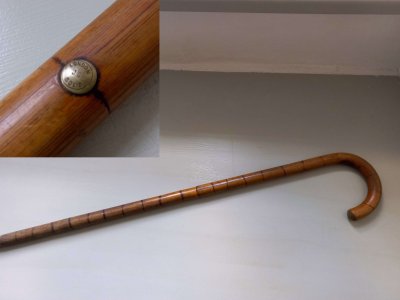
This wooden cane for easy walking, neat work, was purchased in London, as evidenced by the craftsman's information capsule in the middle of the piece. This walking stick, on the one hand, is evidence of some physical weakness of the Metropolitan, since he already had certain diseases, and on the other hand, it is an attribute of his irresistible thirst for an active way of living for the benefit of the people and society.
The Metropolitan was a man of high moral spirit, strengthened by service to God. The museum has an archival photograph stored in the funds, in which the metropolitan stands in a dark cape, leaning on this cane. There are also documented testimonies of monks who personally witnessed the use of this cane by the bishop when he was still able to walk on his own…
Examining this stick-cane, attentive visitors of our museum notice the unusual length of this thing: it is too short for the tall two-meter figure of Metropolitan Andrey Sheptytskyi. It's true.
The reason for this is one story. After the death of the metropolitan during the Soviet occupation, a pseudo-council was held at which the liquidation of the UGCC was announced. After that, the persecution of all key figures of the Church, looting and desecration of the memory of its hierarchs began. Under such circumstances, priests and monks had to hide the personal belongings of Metropolitan Andrey, who remained a symbol of the Ukrainian people's insubordination to Soviet power even after his death. And therefore, one of the priests, Father Volodymyr Hrytsai, who was the metropolitan's secretary in the past years, shortened the metropolitan's cane to his height and used it as his own. This was a guarantee that the walking stick would not be associated with the metropolitan's tall stature, would not be recognized, removed and destroyed, like many other sacred and artistic symbols of the UGCC. Later, in the 1980s, the brother of the father-secretary, Myroslav Hrytsai, personally told the story of the origin of this cane. He also handed over the cane itself, as a relic associated with the holy man, Metropolitan Andrew, and which is at the same time a symbol of the disobedience of the Church itself.
The titular hat of Metropolitan Andrey Sheptytskyi. Cashmere, tassels. 1901 year
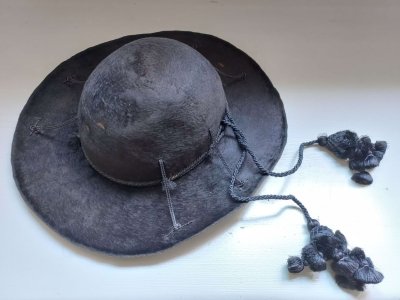
Before us is another equally interesting exhibit, a personal item of Metropolitan Andrey - his hat. This is not the kind of hat that is usually worn by gentlemen or ladies. There are many types of hats in the world, ordinary or status. For example, cardinal, which are worn by cardinals. The hat in our collection is a metropolitan hat. At the time when Metropolitan Andrey was ordained to the bishopric and given the position of head of the Lviv Metropolitanate, the Pope gave him that hat as a sign of a special privilege. Touching its edge, you can feel the tassel. Those tassels are a sign and symbol of metropolitan power.
The cardinal's hat has large tassels: as many as 7 rows, reaching almost to a person's thighs. At different times, this hat was kept as a great memory of Metropolitan Andrey, and now it is an integral part of our museum exposition.
In 1901, on January 17, the metropolitan, appointed bishop of the Lviv Metropolis (Vladika of the Lviv Metropolis), was installed on the throne of the chair of the Lviv Cathedral of St. George.
Metropolitan Andrey's white cloak and black mantle. Cotton and silk fabrics. The end of the 19th - the beginning of the 20th century.
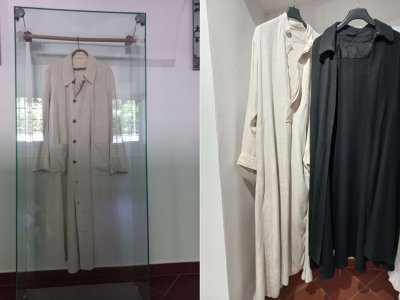
White casual raincoat. Metropolitan Andrey was tall - 2 meters and 9 centimeters. He was a man of powerful constitution, which explains why his cloak is so large. Now let's imagine the fabric: it is white coarse cotton. The metropolitan used this cloak when he stayed and worked on St. Yura Hill in the metropolitan chambers. It was cold in autumn, and he often wore this cloak.
We have an interesting archival picture of the Metropolitan sitting in the same cloak. A reproduction of that picture is located nearby on the wall, next to a glass display case with a cloak. Knowing that the Metropolitan was a count, some prejudices may arise regarding his lifestyle. But, if you touched the cloak, you would feel that its sleeves are sewn and patched. The Metropolitan was a very modest person and demanding of himself. He loved children, respected the poor, widows and orphans. He donated large sums of money for the treatment of the sick, for the education of kids, for the maintenance of orphanages that were attached to the monasteries.
In addition to this cloak, we have another thing of Metropolitan Andrei - a black cape-mantle. Mantle is the outer clothing of monks. It has a collar. The mantle is not long, a little above the knees. Touching the cape, we can pray for protection and God's help through the intercession of Metropolitan Andrei. This robe, like the white cloak from the display case, is worn and shabby. The clothes of the metropolitan are evidence of the great man's extreme modesty.
Rosary of Metropolitan Andrey Sheptytskyi. Wood, lacing. 1906 year.
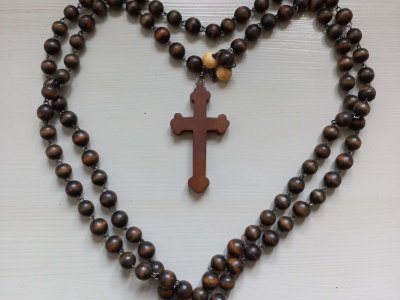
The next exhibit of the museum, which we will get to know, is also a personal thing of Metropolitan Andrey - a rosary that he brought from the Holy Land. This rosary, during the persecution of the Church, was hidden by the Studite monks, who once took care of the metropolitan in his old age and served him. When the metropolitan died, one of the monks, Brother Grigoriy, took this rosary for himself and kept it. Today it is exhibited in our museum.
The following event is connected with this rosary. In 1906, Metropolitan Andrey Sheptytskyi organized a large prayer and pilgrimage to the Holy Land. He was accompanied by almost 600 people who traveled by train from Lviv to Italy, to the city of Trieste. They sailed from Trieste by ship. This trip lasted 6 days one way. For seven days, pilgrims were on the Holy Land, visiting the holy places where Christ was born, where he lived, where he preached, where he was crucified on Mount Calvary, died and gave his life for our salvation and redemption…
Very carefully and interestingly Father Yulian Zerovych described that pilgrimage very interestingly and in detail. There is a very rare and pry photo where the Metropolitan is sitting in a black habit, with a black covering on his head and holding in his hand the same rosary - a rosary that we have the opportunity to touch and feel today.
Film about the construction of the museum
